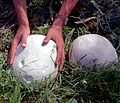Hymenium
The hymenium is the part of a fungus that produces spores. It is a broad flat layer of tissue. This is where cells which make the spores grow. There are two types of cells which produce spores, the basidium and the asci.[1] The hymenium can be found on different parts of fungi, depending on the type of fungi. It could be in gills or pores.[2]
The position of the hymenium is used to identify mushrooms. It is also used to put mushrooms into family groups.
Below are some examples of where to find the hymenium in different types of Basidiomycota and Ascomycota.
- In agarics, the hymenium is on the flat sides of the gills.
- In boletes, it is in a spongy mass of tubes that point down.
- In puffballs, it is on the inside.
- In stinkhorns, it grows on the inside and then comes out as a bad-smelling gel.
- In cup fungi, it is on the inner surface of the cup.
- In teeth fungi, it grows on the outside of tooth-like spines.
Gallery
Gills of the Fly Agaric Amanita muscaria
The bolete Slippery Jack (Suillus luteus) with bright yellow pores
Giant Puffball Calvatia gigantea
The cup fungus Sarcoscypha austriaca
The large angular pores of Polyporus alveolaris, the hexagonal-pored polypore
References
- ↑ https://www.sciencedirect.com/topics/agricultural-and-biological-sciences/hymenium
- ↑ Even-Flint, Jeremy (1 October 2020). "Structure and function relationships in the fungal kingdom". Central Texas Mycological Society. Retrieved 12 January 2024.
- Régis Courtecuisse, Bernard Duhem : Guide des champignons de France et d'Europe (Delachaux & Niestlé, 1994–2000). ISBN 2-603-00953-2
Other websites
- IMA Mycological Glossary: Hymenium
- IMA Mycological Glossary: Subhymenium
- APSnet Illustrated Glossary of Plant Pathology: Hymenium Archived 2006-05-27 at the Wayback Machine Hymenium of an ascomycete, Monilinia fructicola
- Jack Murphy Mycological Images: Hymenium Archived 2007-03-20 at the Wayback Machine Hymenium of a basidiomycete, Russula laurocerasi





